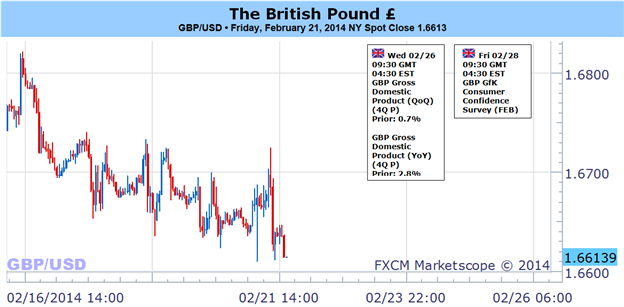US Dollar Needs S&P 500 Volatility to Leverage a Rally
Fundamental Forecast for US Dollar: Neutral
- Risk trends are keeping the USDollar from a more substantive rally – but an S&P 500 1,850-break can change that
- With vows that the Taper is entrenched, the market will look to Yellen and other Fed speakers for rate guidance
The Dow Jones FXCM Dollar Index (ticker = USDollar) rose every day of the past trading week. We haven’t seen a five consecutive day advance from this benchmark since the run through November 1 – notably the beginning of an impressive bull run for the greenback. Yet, there is something still distinctly absent from the dollar in this turn: conviction. Momentum on this rebound is just as tepid as it was in the 10-day slump that preceded it. So long as the Taper isn’t put on hold or the market isn’t struck by a renewed appetite for expensive ‘risk’ assets, the dollar may be left to drift higher. But if the currency wants to truly rally, traders may need to be inspired by recognition of the Fed’s first rate hike or a S&P 500 collapse below 1,800.
In assessing the dollar’s fundamental bearings, there are two major themes that seem to be capable of taking the rudder over for extended periods: Fed monetary policy speculation and general risk trends. Between the two, investor appetite has the ability to be the most explosive and thereby influential.
It’s no coincidence that the USDollar began its turn when the S&P 500 – a benchmark for investor sentiment – stalled below 1,850. Yet, the halt below record high resistance for the stock index didn’t naturally segue into the long overdue reversal. With the equity market effigy holding just below its all-time highs into the week’s open, it is more likely that we see an upside breakout for stocks and a pang of disinterest for the USD.
Yet, the potential for risk trends is asymmetrical. While probability favors a buildup of risk exposure after a five-year bull trend, the follow through is growing increasingly difficult to muster as participation flags and exposure (leverage and relative high-yield interest) hits record levels. In contrast, fewer traders and greater sensitivity via geared positions marks the kind of conditions that can evolve into a disorderly rush for the exits. A great visualization of this is equity (VIX) or FX-based (FX VIX) volatility index. There is very little risk premium (1.5-3.0 ‘vols’) left before we hit natural / record lows. The correlation between USDollar and the FX VIX is an exceptional 0.83.
The threshold to turn complacency and the grab for yield off pace and ultimately send market participants scrambling is proving exceptionally high. We need something that overrides confidence in a stimulus-protected world. Emerging Markets proved the most provocative threat we’ve seen in some time earlier this month. Yet, the contagion eased before it hit critical mass. We shouldn’t, however, write the risk off though. There is plenty of EM-based event risk this week and the G20 is unlikely to tender a meaningful policy to safeguard the group from its excesses.
In reality, the turn in sentiment will likely evolve out of extreme positioning and necessary market rebalancing that inspires fear, but a catalyst is what traders remain on the lookout for. As it happens, a primary source of the confidence build up to this point will also prove a point of anxiety going forward. The FOMC has already Tapered its QE3 program twice so far, and the impact seems tepid. Yet, this is an underlying current that will build momentum and influence. When the turn is made, there will be plenty of fuel to burn.
Assessing the outlook for stimulus, we are met with another lop-sided situation. The Fed has said it could increase stimulus if it were needed, but policy official after policy official has said the threshold to even ‘stop’ the Taper is very high. As the stimulus program winds down, the reality of investors accepting their own risk will become more evident. Yet, the true tipping point – for moral hazard and the dollar – will be the moment the market recognizes the first Fed rate hike is on the horizon. To help set this timetable, we have Fed Chair Yellen’s Senate testimony and a round of Fed speeches (on the economy, QE and policy guidance) this week.


 LinkBack URL
LinkBack URL About LinkBacks
About LinkBacks







 Reply With Quote
Reply With Quote










Bookmarks